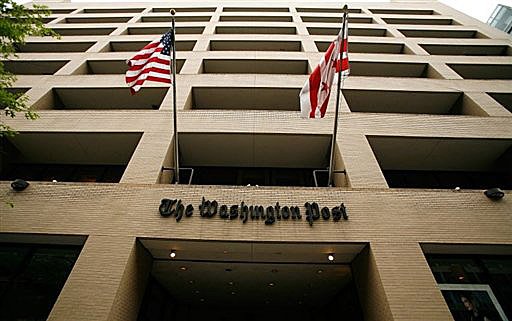Washington Post Earnings Brought Down by Washington Post
 The Washington Post company had a surprisingly good year in 2009:
The Washington Post company had a surprisingly good year in 2009:
The Washington Post Company (NYSE: WPO) today reported net income of $91.2 million ($9.78 per share) for the fiscal year ended January 3, 2010, up from $65.8 million ($6.87 per share) for the fiscal year ended December 28, 2008. Net income for the fourth quarter of 2009 was $82.2 million ($8.71 per share), up from $18.8 million ($2.01 per share) for the fourth quarter of 2008.
The Washington Post newspaper . . . not so much:
The newspaper division reported an operating loss of $163.5 million in 2009, compared to an operating loss of $192.7 million in 2008. For the fourth quarter of 2009, the newspaper division reported operating income of $3.2 million, compared to an operating loss of $14.4 million in the fourth quarter of 2008. Excluding early retirement program charges, accelerated depreciation and goodwill impairment losses, operating results declined in 2009 due to the significant decline in division advertising revenue, offset by expense reductions. Excluding accelerated depreciation and goodwill impairment losses, operating results improved in the fourth quarter of 2009 due to expense reductions. Newsprint expense was down 19% in 2009 and 22% for the fourth quarter of 2009 due to a decline in newsprint consumption and prices.
You can read the whole report for yourself, but the discrepancy is almost entirely a function of the company’s Education division, aka Kaplan, which earned $2.64 billion and netted $194.8 million. Additionally, its cable television division brought in $750.4 million.
Someone’s going to do the math one of these days and decide that the namesake division of the Washington Post Company isn’t pulling its weight.
Hat tip: WPCo employee (Foreign Policy division) Annie Lowrey





It’s the “Agenda Journalism” business model dontcha know!
Agenda journalism has nothing to do with it. It’s all about digital. This has nothing to do with politics.
The ink-on-paper deliver-by-truck model for newspapers, magazines and books is dying. It’s Dick Cheney at this point: you know it’s not going to last long, we just don’t have an exact date.
It’s going to keep spiraling down as the readership ages and becomes less and less attractive to advertisers. They react by cost-cutting which diminishes the value of their core product: news. Which just accelerates the death spiral.
But they need at the same time to realize that the web as currently conceived isn’t doing it for them, either. Right now they’re giving their product away for free online, which cannibalizes their dwindling ink-on-paper readership. Trading paying readers for non-paying readers.
I don’t have a solution for them, although I think I see how books make the jump.
I was downloading an occasional copy on my Kindle. That has stopped since they hired Thiessen,
Steve
Considering the filth that The Washington Post recently hired, few should shed too many tears at the newspaper’s slow death…